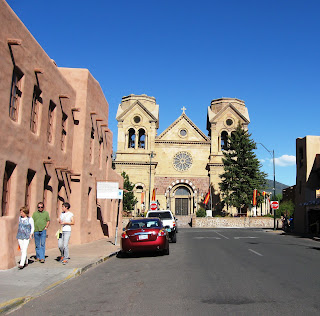 Every time we travel, we seek out river access, mainly because I like to say I've touched the river. On this trip to New Mexico, I stood in the Pecos river a couple of times; I also dipped my fingers into the Rio Grande right where it runs beside the road that connects Santa Fe and Albuquerque.
Every time we travel, we seek out river access, mainly because I like to say I've touched the river. On this trip to New Mexico, I stood in the Pecos river a couple of times; I also dipped my fingers into the Rio Grande right where it runs beside the road that connects Santa Fe and Albuquerque.
We stopped at Bernalillo to see a museum detailing Francisco Vasquez de Coronado's stay among the Kuaua Pueblo, a Tiwa speaking tribe who had taken refuge at this spot to escape a drought in their previous more northerly home.
They had been here a couple of hundred years when Coronado discovered their village of adobe apartments--some as high as three stories. The homes were little more than cubicles with holes in the roofs and ladders for access.

Fortunately, the people spent most of their time outdoors, cooking in clay ovens, raising crops, shepherding livestock, and fishing. There was precious little moisture, but the Rio Grande was close by for irrigation, and the altitude kept the temperature pleasantly cool.

There were large Kiva's--like the club in Great Britain I imagine--and the men sat around spinning and weaving all the cloth--unlike the men at the clubs in Great Britain I imagine.



Turtle and I took the usual hike around the museum grounds and I took pictures. I thought they had a unique way to keep people on the hiking trails. If you read the sign you'll see what I mean.

Another Coronado place we visited was a village called Puerta De Luna, because Coronado and his men watched the moon come up nightly through a cleft in the mountain there.
 They also stayed long enough to build a crude bridge across the Pecos River. There's a much nicer one today, with public access for fishing and a lot of trout--despite the ongoing drought. The water was clear enough to watch them swim right up to the fly on the end of Turtle's fishing pole, sniff at it, and rapidly head upstream for something tastier.
They also stayed long enough to build a crude bridge across the Pecos River. There's a much nicer one today, with public access for fishing and a lot of trout--despite the ongoing drought. The water was clear enough to watch them swim right up to the fly on the end of Turtle's fishing pole, sniff at it, and rapidly head upstream for something tastier.


 We wandered around the village and took pictures of this little chapel, and the church that replaced it over a century ago.
We wandered around the village and took pictures of this little chapel, and the church that replaced it over a century ago.


The ground was bare and dry, but occasionally cactus flowers and jeweled weeds sparkled in the sand.

Birds were plentiful--large birds, pipers, buzzards, and hawks, and the cliffs in the distance made the place beautiful despite the lack of greenery.

That wasn't enough for Francisco Vasquez de Coronado, evidently. He had one thing on his mind-- the seven golden cities of Cibola and how to find them, since nobody had given him a map with X marking the spot.
Wearily, he ordered his men to take up their goods and follow him to fabled treasures beyond the desert mountains.
For an explorer who never accomplished his goal, he certainly got a lot of mentions.




















